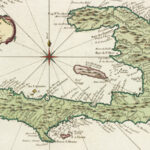Last Thanksgiving, on a family getaway to Miami, I was confronted with a question that I’d never considered but haven’t been able to get out of my head since:
How is it possible for a man to look good sprawled out on a beach in a three-piece suit?
Complete with a fedora, no less?
This important quandary of the human condition arose while I gazed upon a wall of film stills at the legendary Fontainebleau, “America’s First Luxury Resort.” Opened in 1954, no less an expert in opulent indulgence than Groucho Marx proclaimed it the “Eighth Wonder of the World,” and the eleven-story Fontainebleau planted its flag as the place to be and be seen in what was then a much sleepier South Florida scene. It would quickly become a winter home for all kinds of celebrities and entertainers, including Frank Sinatra. In 1960, he hosted a Timex special featuring a young serviceman just back from a three-year Army hitch in West Germany. “Welcome Home Elvis” was a huge hit, capturing 68% of the American television audience, swooning as the crooners delivered a bikini-dropping “Love Me Tender”/”Witchcraft” duet.
Sinatra would become synonymous with the Fontainebleau’s early era, performing hundreds of times over the years at the LaRonde Supper Club (today, the infamous club LIV), which inspired the 2015 Sinatra centennial birthday dedication of the photo corridor. The walls are adorned with Sinatra pics from his personal family collection, the catalog of renowned photographer Terry O’Neill, and various other “Frankie at the Fontainebleau” snaps, like the one where he’s chilling on the beach in $1,000 custom duds. A photograph so alluring that it sent me–neither a Sinatra obsessive or completist, just a normal Ol’ Blue Eyed fan–on a quest to learn everything I could about it. Which is how I came to know the private detective, Tony Rome.
***
Born in 1924 (and following his World War II years as a radio officer in the Merchant Marine), paperback rack writer Marvin H. Albert would have a forty-year career churning out some 70+ western, crime, mystery, adventure and movie tie-in novels. In 1960, he authored “Miami Mayhem,” the first of three stories featuring Tony Rome, a one-time-cop/full-time-degenerate-gambler turned PI-for-hire who lives and loves on “Straight Pass,” his powerboat home thanks to a rare successful night shooting dice. I was so struck by this heretofore unknown book-film combo that I went all-in. I found a used copy of (the re-named in 1967) “Tony Rome” online, a full reprint of “The Lady in Cement” on the Internet Archive, and a two DVD-set of the cinematic adaptations, as streaming wasn’t an option. (The third pulp, “My Kind of Game,” was harder to find and not made into a Sinatra movie; It will remain a literal mystery).
Part of what captured my intrigue was that the series checks one of my favorite sub-genre-genres, what I was going to cleverly call “Sunshine Noir.” That was until I realized it’s an unoriginal notion, and was informed by one of its finest practitioners, inaccurate and trite. Alex Segura, the Miami native behind the deliciously twisted and debauched Pete Fernandez series, cut from the same swampy murder-in-the-tropics cloth as the Rome books, explains.
“I’m generally a pretty easy-going guy, but the one thing that can pull me into a heated debate is the discussion of ‘what defines noir.’ In my mind, it’s become watered-down, a marketing term akin to ‘hard-boiled’ or even just ‘crime.’ It’s much more complex than that, which is what makes Florida the perfect setting for it,” says Segura. “Noir is about people forced to do things out of a desperate, primal need to make up for, or fix a mistake driven by lust, greed or some other base desire. Stories usually end in a bad way, which also makes noir unique. The endings aren’t tidy or plot-driven. People do terrible things and pay the price. What better place to showcase the contrast? The dark underbelly where these characters move and live, lit by the Sunshine State.”
Segura is dead-on because what makes Tony Rome’s forgotten world come to sordid life isn’t a generic catch-all for criminality happening when the summer winds came blowin’ in. It’s because the stories are set in-and-around a specific Miami, a smaller less-developed laid-back burgh years ahead of Tony Montana, 2 Live Crew, Crockett and Tubbs, and the Cocaine Cowboys defining it, fairly and not, as America’s primo international ‘80s party town. Albert takes great pains to set scenes in a variety of Miami neighborhoods both familiar and less-traversed–the man has a real affinity for highly specific driving directions–but it all plays out differently in 1960. The city population was less than 300K, only one public school had been desegregated, and the “Freedom Flights” that would permanently change the city’s political and cultural foundation were a few years in the future.
“When the Albert books were written, Miami was a more traditionally southern city figuring out its identity. Even after the immediate, post-Castro Cuban migration, it still developed at a slower pace,” says Segura, whose latest thriller, “Alter Ego,” is set in another world he knows intimately, comic books. “Once the 80s kicked in, the city went into hyperdrive. I think exploring the contrast of a Miami most folks never understood even existed can be fascinating. It’s something I play with a bit in the Pete Fernandez Quintet.”
Nowhere is this more true than in the spectacular Miami film locales in Tony Rome and The Lady in Cement. Descriptions on the page don’t do justice to what it’s like taking in Collins Avenue, the Old Seven-Mile Bridge, Marathon Key, the 5th St. Gym, the Wreck Bar, Biscayne Bay, Gulfstream Park, and as a mansion of malfeasance, the magnificent Vizcaya Museum & Gardens, all soaked in JFK-era panache. (The movies were released in ‘67 and ‘68, but outside of a groovy go-go bar and a car chase set to psychedelica, Sinatra’s Tony Rome lives in a “Nice ‘N’ Easy” Camelotian world.) Mix in a gangster’s row of sexily-clad starlets including Sue Lyon, Jill St. John, Gena Rowlands and Raquel Welch, and you’ve got the world on a string, sitting on a rainbow.
In and of themselves, Albert’s dime-store efforts are solid because even in the Floridian humidity, he doesn’t let readers see him sweat. The chapters are taut, the pacing swift, and the shaggy dog plots don’t get hung up on twists, turns, reversals or double-crosses. Tony Rome gets hired, follows leads, takes some beatings, drinks a few brandies, makes a bunch of wagers (often in a running gag from inside the police station), grills a few suspects, and puts the pieces together while bodies pile up around him. Cases get closed, Rome gets paid, blows his winnings at the Jai Alai courts, and goes fishing. All in a day’s work on the Straight Pass.
Albert’s true strength is engulfing readers in the soupy South Florida “anything goes” atmosphere of sweet mojitos and salty murders. Exhibits A and B:
“Miami Mayhem”
Ralph Turpin lay waiting for me on the floor of my office. A bullet had smashed through his forehead and destroyed the brain inside.. He was as unreal as a waxworks dummy now. The abusive violence and unclever trickiness that had been Ralph Turpin were gone. He was just a bulky corpse in a shiny, shabby suit….
For the stronger tourists, Miami Beach is a town where there is no end to one day and no beginning to another. The days and nights just go round and round, interrupted only by haphazard cat naps whenever the legs start to buckle with exhaustion. They come down there for fun, pay through the nose for it, and their time is limited. They hate to waste a moment of it sleeping.
“The Lady in Cement”
I was thirty feet under the surface of the ocean when I first saw the naked woman standing below me…The water was a brilliant, clear turquoise. I could see her distinctly. Her face was tilted up toward me, her eyes staring with a frozen wildness, her water-filled mouth strained wide open as though she were screaming at me…
It wasn’t the first dead body I’d ever come upon. A private detective in Florida has to develop a certain amount of emotional armor or get out of the business. But I wasn’t prepared to find it out there, under the sea, where I sought escape from the unpleasant realities of what people were capable of doing to each other.
***
Stand-alone the novels would’ve been fine, a few hours passed in between oceanside Daiquiris. So let’s return to the Fontainebleau, to gaze upon the glamour shot that led me down the Palmetto Expressway rabbit hole to discover the true Tony Rome, Francis Albert Sinatra.
The character backstory is important here because Sinatra took it to heart. Prior to his five years at sea, Tony Rome was a Miami police officer, just like his father, a captain in charge of the police commissioner’s special squad investigating racketeering connections. He went down in a scandal of his own making. Captain Rome dug too deep into the rich and corruptible, until the tables were turned, and it was revealed he’d taken a large bribe to suppress evidence in a hit-and-run case involving a wealthy failson. The dutiful cop’s son learned his cop father ate his gun on the front pages of the evening papers. Rome worshiped his old man, so he took the ethical breach hard, but he also knew an honest cop’s salary couldn’t pay for a dying wife’s-mother’s medical bills and his son’s college tuition for a brighter future. After the suicide, he bitterly walked off the job into the aimless life of a private dick who never met a dollar he couldn’t bet.
Sinatra embodies this Tony Rome to a tee. He was in his mid-50s when the movies were made, and by the late 1960s even his old pal Elvis had been shunted to the side by Flower Power folk, the British Invasion, and Black Power anthems. Sinatra wasn’t yet the bitter Las Vegas lounge act of “My Way” he would become, but his time as an arbiter of swingin’ youth culture was over. His underrated acting career was even fizzling out, the days of The Manchurian Candidate, The Man With the Golden Arm and From Here to Eternity were behind him. He would only appear in a few more films, none worthy of the “In Memorium” highlight reel.
Maybe it’s in part because I’m now of the aging middle-aged age Sinatra was then, but I see the resignation in Tony Rome’s face now. He’s wary, and weary, by default. A person’s 50s involve the realization there’s more years behind than ahead, which can turn into regret or relief. One will eat you alive, the other offers the freedom to hit the beach, comfortable in your own skin. Or tailored Sy Devore. And sure, Tony Rome can pull it off while he laconically chases bad guys, but at no time does it ever seem like he wouldn’t rather be in a comfy chair on his boat deck, phoning in trifectas on the Flamingo Stakes. He’s a drinker, but not a drunk, an important difference in the seedy worlds fictional PIs inhabit. Getting up out of the gutter every day is hard on the joints.
As for the dames? The truest depiction of a man whose sole need is to wrap up business for a cold beer and a hot bookie in the Floridian sun, is shown when Tony Rome–as played by a legendary Lothario–doesn’t bed the women he meets, too much effort. (Well, except for Raquel Welch. Come on, The Lady in Cement wasn’t a fantasy film.)
Masterpieces, either books or movies? No, not at all, but that doesn’t change how happy I am to have laid eyes on that Fontainebleau display. Tony Rome took me on an enjoyable journey through Miami’s past. A ride best encapsulated in wrapping up with an understanding of why a no-longer-young-but-still-nonchalant Frank Sinatra felt wholly comfortable on the beach in a three-piece suit.
Complete with a fedora, no less.

















